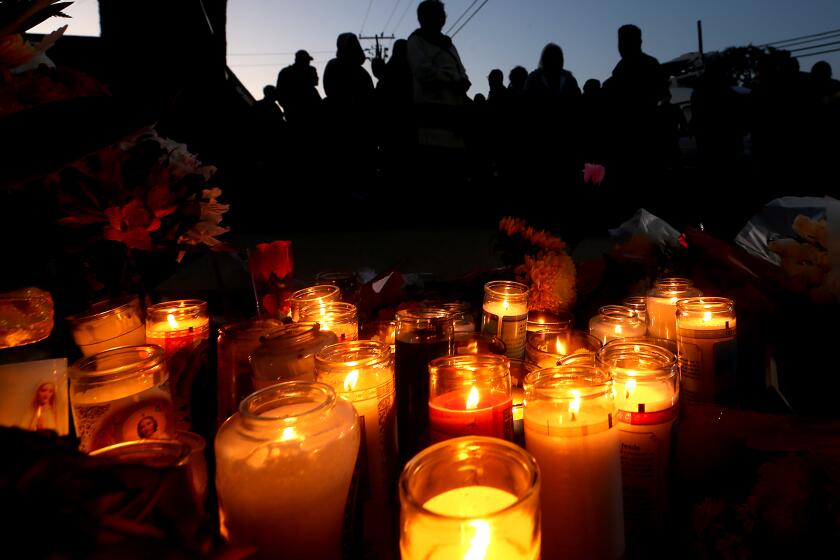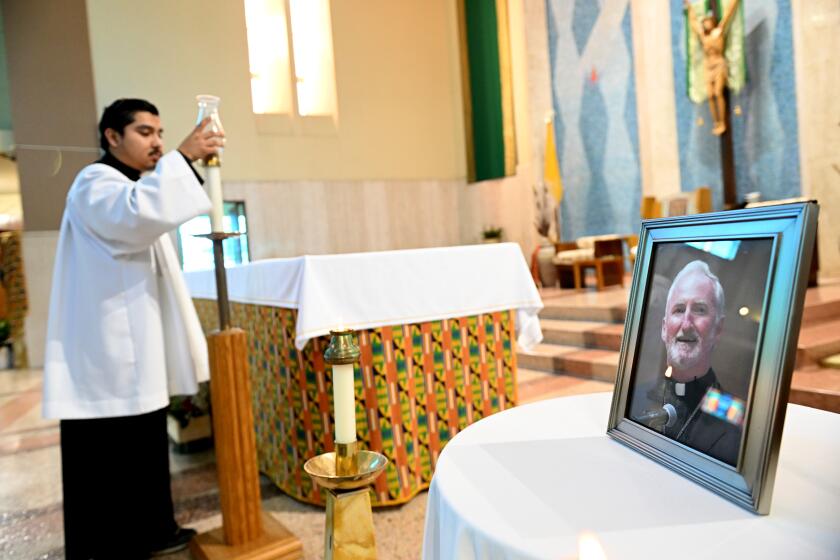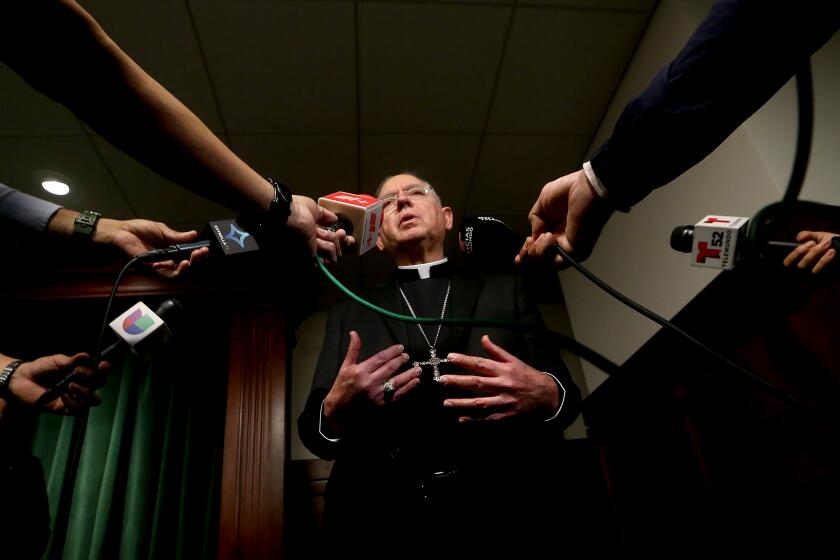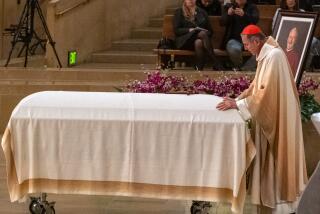Handyman confesses to killing L.A. Bishop David G. O’Connell, district attorney says
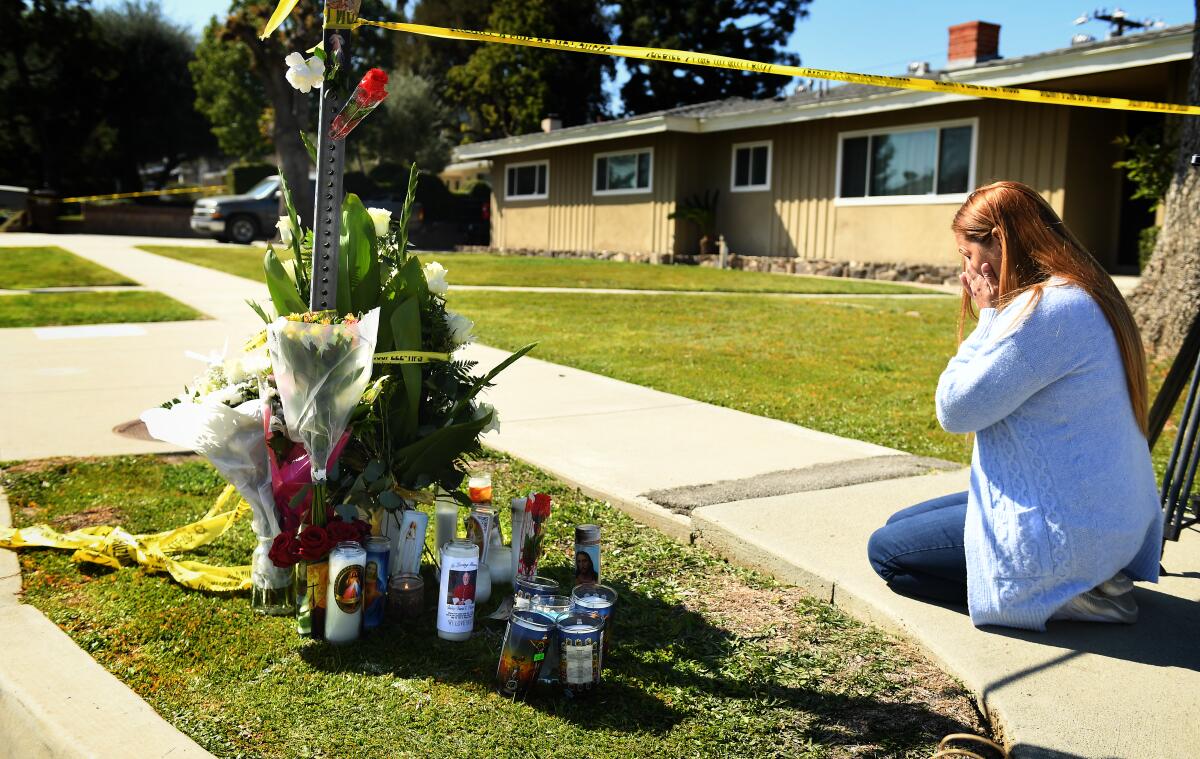
A 61-year-old man who prosecutors said has admitted that he killed Bishop David G. O’Connell was charged Wednesday with one count of murder in the shooting death of the much lauded religious leader.
Carlos Medina, a handyman whose wife worked as a housekeeper for the bishop , also faces a special allegation of using a firearm during the crime, Los Angeles County Dist. Atty. George Gascón announced during a news conference Wednesday. If convicted, he could face 35 years to life in prison.
In detailing the charges, Gascón said Medina admitted to the killing to investigators.
“I know this has been a shock for our community,” Gascón said. “This was a brutal act of violence against a person who dedicated his life to making our neighborhoods safer, healthier and always served with love.”
Medina is accused of killing the 69-year-old priest Saturday in his Hacienda Heights home, where he lived alone.
A man with humor, a deep commitment to social justice and dedication to serving the Black and Latino communities
“His loss is one that I really feel will be felt for years to come,” Gascón said. “Charging Mr. Medina will never repair the tremendous harm that was caused by this callous act.”
O’Connell was found dead Saturday in his bedroom with multiple gunshot wounds, Gascón said.
In an interview, Gascón said O’Connell was likely asleep when the shooting occurred.
“By all counts, Bishop O’Connell was a saint for Los Angeles,” he said.
Law enforcement sources familiar with the investigation said the firearm involved was a small-caliber weapon and that O’Connell’s wounds weren’t clearly visible to the deacon who first discovered the bishop’s body.
According to the sources, the bishop was shot five times.
Neighbors said they heard no gunshots or unusual noise coming from the home until deputies and paramedics descended on the quiet neighborhood just before 1 p.m. Saturday.
Medina was taken into custody at his Torrance home Monday, after he barricaded himself for some time. Inside, investigators recovered two firearms, including a .38 caliber handgun that detectives suspect he used to kill O’Connell, according to sources familiar with the investigation.
The killing of Los Angeles Bishop David G. O’Connell brings disbelief and mourning.
Investigators were led there two days after the slaying, aided by a tipster who told officials that Medina had been acting strangely since the killing, Los Angeles County Sheriff Robert Luna said Monday after announcing the arrest.
Surveillance video also showed a “dark, compact SUV” — believed to belong to Medina — at O’Connell’s home at about the same time the killing took place, Luna said.
Medina appeared briefly in court Wednesday afternoon, where Judge Armenui Amy Ashvanian set bail at $2.3 million.
A Spanish language interpreter relayed the court proceedings to Medina, but he did not speak during the short court appearance.
His arraignment was scheduled for March 22.
Officials have yet to disclose what may have motivated the killing. After announcing Medina’s arrest, Luna said the tipster who pointed law enforcement to the suspect said Medina had claimed that the bishop owed him money related to his work as a handyman.
Sheriff’s Lt. Michael Modica said that when Medina was interviewed, he provided several reasons for the killing, but “none of them made sense to the investigators.”
“We don’t believe there’s any validity to the owing of money,” he said, referring to the motive suggested by the tipster.
Los Angeles County Public Defender Ricardo Garcia said in a statement to The Times that Medina “is presumed innocent and entitled to a vigorous defense.”
“We are sensitive to the impact this case has had on our community but at the same time caution against any rush to judgment, either by the public or the media, until all the facts are established in court,” the statement said.
Deputy Public Defender Pedro Cortes, who was assigned to represent Medina in court, did not respond to a request for comment.
Medina has a lengthy history of personal drug use arrests and convictions from 2005 to 2017, and detectives are investigating whether he had been using narcotics at the time of the killing, according to law enforcement sources.
Medina has narcotics arrests in 2005, 2007, 2011 and 2017, according to law enforcement officials not authorized to discuss his criminal history. At least two of the convictions were for drug possession, but the handyman did not have a history of violent arrests.
The suspect in Bishop David O’Connell’s shooting death is married to the clergyman’s housekeeper.
In the unincorporated Torrance neighborhood where Medina and his wife rented a two-bedroom yellow stucco home, neighbors said the couple led quiet, ordinary lives and were friendly with their neighbors.
“He never said anything offensive,” said Francisco Medina Lopez, 74, a neighbor who said he was friendly with Medina. “It’s so strange.”
Medina, who walked with a limp, was often seen tinkering on his cars or working on his yard, neighbors said. His wife was a fixture in the neighborhood who was frequently observed walking a large white dog that residents said belonged to the bishop.
The two neighbors would occasionally drink beers or share meals together, making small talk while listening to ranchera music.
Although Medina’s wife worked for the bishop, Medina Lopez said the couple didn’t seem particularly religious and didn’t bring it up in conversations or decorate their home with Catholic objects and images.
But Medina Lopez said he always thought well of his neighbor, who would sometimes give him a ride to the swap meet or nearby stores.
“He was your average older man, always talkative and in a good mood,” said Luis Lopez, who lived in a home behind the Medinas’ home. “He was a regular common man.”
After news of the bishop’s death spread, about a dozen people stood with candles and prayed the rosary Saturday beside police tape near his home.
O’Connell, who earned the title of bishop in 2015, was a “peacemaker with a heart for the poor and the immigrant,” Archbishop José H. Gómez of the Roman Catholic Archdiocese of Los Angeles said in a statement Sunday.
“He had a passion for building community where the sanctity and dignity of every human life was honored and protected,” the statement by Gómez read. “He was also a good friend, and I will miss him greatly. I know we all will.”
Born in County Cork, Ireland, O’Connell studied for the priesthood at All Hallows College in Dublin and was ordained in 1979, according to the archdiocese.
He served as associate pastor at several parishes in Los Angeles, including at St. Frances X. Cabrini in South Los Angeles for 14 years. He then became pastor of Ascension, where he oversaw a congregation of about 4,000 families and two schools with about 500 students.
In the neighborhoods he served, he was known as a calming intermediary, especially after the 1992 riots. The Catholic News Agency reported at the time that O’Connell, not yet a bishop, worked at trying to rebuild trust between police and the South L.A. community.
He also served as founder and chairman of the interdiocesan SoCal Immigration Task Force, which helped children who had entered the United States without adult companions.
“He was the help of the helpless and the hope of the hopeless,” said Los Angeles County Supervisor Janice Hahn Monday during an emotional news conference.
Gómez fought back tears and his voice cracked Monday as he called O’Connell “a good friend of Los Angeles.” He recalled the bishop’s fluent Spanish, tinted with a Irish accent.
“Every day he wanted to show compassion to the poor, to the homeless, to the immigrant and to all those living on society’s margins,” Gómez said. “He was a good priest, and a good bishop and a man of peace.”
More to Read
Sign up for Essential California
The most important California stories and recommendations in your inbox every morning.
You may occasionally receive promotional content from the Los Angeles Times.
